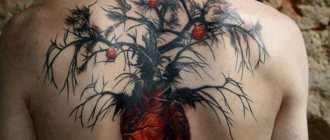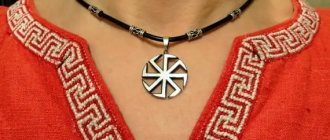Tree as an ancient symbol
The tree, as an ancient symbol, also signifies the feminine principle; food, shelter, protection and support provided by the Great Mother; the power of the inexhaustible and fertility-giving waters that she controls. Trees are often stylized to resemble a female figure.
Immersed by its roots in the bowels of the earth, in contact with the waters in its center, the tree grows in the world of Time, growing rings as an indicator of its age, and its branches reach heaven and eternity, symbolizing differences in terms of manifestations of the material world.
The evergreen tree signifies endless life, undying spirit and immortality.
A tree, as an ancient symbol, like a grove, a mountain, a stone and waters, can symbolize the cosmos in the fullness of its connections.
The cosmic tree is often depicted growing on the top of a mountain, and sometimes at the top of a column.
The ancient symbols of wood are pillar, pole, jagged pole, branch, etc. They are often depicted accompanied by snake, bird, stars, fruit and various lunar animals.
Trees that bear the fruit of life are sacred. These include grapevine, mulberry, peach, date, almond and sesame.
In Christianity, a tree is an image of a person, since it will bear fruits of both good and evil at the same time.
On the other hand, it is a symbol of resurrection, since it brings renewal through the death of Christ on a wooden cross, which was made from the Tree of Knowledge, and thus salvation and life were found on the same tree due to which the Fall and death occurred , and the conqueror was conquered.
The Cross is sometimes identified with the Middle Tree, as the vertical axis of relations between Heaven and Earth.
In medieval Christian symbolism, the Tree of the Living and the Dead was known, bearing the fruits of good and evil growing on its different sides.
Its trunk was Christ as the ancient symbol of the central cross on Calvary. This tree was the emblem of Saint Zenobia.
Varieties of aichrizon
To date, almost two dozen species of succulent plants from the genus Aichrizon have been described and classified. Some of them have successfully adapted to home conditions and delight their owners with luxurious blooms.
- Aichryson x domesticum
A popular hybrid species obtained through the selection of two varieties of succulent - tortuosum and punctatum.
The height of this low bush is no more than 30 cm, the diameter varies from 20 to 30 cm. The leaf blades are club-shaped, with transparent whitish hairs on their surface.
Homemade aichrizon blooms for quite a long time; with quality care, this period can last from May to October.
- Aichryson sedifolium
It grows in the form of a dense succulent subshrub with erect, thin stems, their height varies from 15 to 40 cm. The leaf blades are strong, dense, club-shaped, they form rosettes, the size of which is 12–13 cm.
The faded green or yellowish-green leaves have a sticky surface and are decorated with red speckles at the edges and on the ribs. There is no edge on the foliage.
Sedum-leaved aichrizon blooms in spring, with racemose, large inflorescences consisting of yellow-golden star-shaped flowers. This type of indoor aichrizon has one peculiarity - the succulent partially loses its foliage when the dormant period begins.
One nuance should be taken into account - this type of love tree is more sensitive to overflows and stagnation of moisture in the soil. In such conditions, the rhizome of the succulent rots.
- Aichryson laxum
The second name of the spreading bush is prostrate aichrizon. The height of the tree, as well as the diameter, do not exceed 40 cm. Its foliage forms rosettes, it is covered with a short, whitish-transparent edge consisting of small hairs.
The blades of green diamond-shaped leaves are on 1.5-3 cm petioles. The flowers are painted in yellow-golden tones, they form large tassels, their length can reach 30 cm.
Loose aichrizon blooms in the spring, in April - May, and this period lasts for 5-7 months. This variety of succulent also drops most of its foliage when it finishes flowering. In this case, the plant itself does not die.
It is important! You can help your pet grow green mass faster by fertilizing it and replanting new soil. But this applies to specimens with a well-grown root system.
- Aichryson tortuosum
Another decorative variety of the tree of love, loved by many gardeners. This compact succulent bush has 15–30 cm stems covered with diamond-shaped, fleshy green leaves. The plates are covered with small villi, forming a white edge.
The plates are on short petioles and form rosettes. The succulent begins to bloom in the spring and lasts for 5–6 months.
These are not all varieties of plants of the genus Aichrizon; in the home collections of succulent growers you can find rarer specimens of love trees. But, regardless of popularity, almost all aichrizones require similar conditions of maintenance and care.
Tree of Life, Tree of Knowledge and World Tree - what do they mean?
The Tree of Life and the Tree of Knowledge grow in Paradise.
- The first grows in its center and means restoration, a return to original perfection. This is the cosmic axis, symbolizing unity beyond good and evil.
- The second tree is obviously dual, for it bears the fruits of good and evil.
In many traditions, this correlates with the first man and his loss of the paradise state, as well as with the waning and waxing phases of the moon, death and rebirth.
The Tree of Life, as an ancient symbol, also symbolizes the beginning and end of a cycle: it has twelve fruits (sometimes ten), which are forms of the sun and which will appear simultaneously at the end of the cycle as manifestations of the One.
Immortality can be achieved by eating fruit from the Tree of Life or drinking moisture obtained from this Tree. The Tree of Knowledge is often depicted as a vine (in vino Veritas).
World Tree
The World Tree is a symbol of the universe. According to Slavic mythology, the world tree - the axis mundi - stands on the outskirts of the Universe (near Lukomorye), its top rests on the heavens, and its roots reach the underworld.
The gods ascend and descend along this tree, and you can use it to penetrate into other worlds.
“The Tale of Igor’s Campaign” talks about the legendary singer Boyan, who traveled along the tree, turning into a mouse (aka a squirrel, corresponding to the middle, i.e. earthly, world), into an eagle (corresponding to the sky) and into a wolf (the underworld). .
In a traditional home, a mandatory element was a pole (in nomadic cultures) or a pillar (among sedentary peoples), which also symbolized the axis of the universe.
In East Slavic ornaments, the world tree as an ancient symbol was depicted conventionally. The crown is in a curled, not yet blossomed form, shoots in the middle of the trunk, two roots and between them the grain from which the tree grew.
Building a house, planting a tree and raising a son meant living life correctly and being fulfilled.
LiveInternetLiveInternet
Trees are nature's supreme symbol of dynamic growth, seasonal dying and regeneration.
Many trees have been considered sacred or magical in various cultures. Respect for the magical power of trees is based on primitive beliefs that gods and spirits live in them.
The symbolism of animate trees has been preserved in European folklore in the images of the tree man or the green man. In fairy tales, trees can both protect and fulfill wishes, and cause obstacles and be frightening and even demonic creatures.
ACACIA
A symbol of immortality, especially in the Jewish and Christian traditions. Acacias were used in the construction of shrines and tabernacles in temples. Some believe that the thorny crown of Jesus Christ was woven from acacia. Red and white acacia flowers symbolize the duality of life and death. A knotted acacia stick was used by Freemasons in initiation ceremonies and as a mourning attribute.
BANYAN
Sacred tree of India; perhaps it was the banyan tree that became the initial model for the “inverted” Cosmic Tree of the Hindus and Buddhists. Through the exposed “aerial roots” of the banyan tree, in their opinion, the transcendental spirit of the universe is collected and concentrated. Sometimes temples are built among the numerous “aerial roots”.
BIRCH
A healing, protecting tree in northern Europe and among Asian peoples, a sacred tree of the German gods Thor and Freya, and in the east the main element of shamanic rituals, in which it plays the role of a Cosmic Tree, connecting the earthly and spiritual levels of the universe. The central pole of round Asian tents (yurts) was made from birch, which made it a sacred tree in initiation rituals, a symbol of a person’s spiritual ascent through life, as well as cosmic energy. In Russia, the birch symbolizes spring and girlhood, and is the emblem of young women; it is planted near houses to call upon good spirits. The birch tree's ability to cast out evil spirits was probably the reason why witches were flogged with birch rods during exorcism rituals. Birch is the official national tree of Estonia.
HAWTHORN
In Europe, since ancient times, the tree and its flowers have been endowed with magical properties and associated with the name of the god of marriage, Hymen. Flowers were used for wedding wreaths, wood for wedding torches.
The association between its spring bloom and virginity has led to the popular belief that it protects chastity. For others, the faint fishy scent of its flowers foreshadowed death if brought into the house.
ELDERBORN (SAMBOOK)
In Northern Europe, especially in Denmark, it was considered a magical tree. They believed that making furniture from its wood was a bad sign.
BRANCH (BRANCH)
The branches bore the symbolism of the tree from which they were cut, which was widely used in spring rites in honor of the gods of fertility. Waving a palm or olive branch was considered a sign of triumph during processions.
Sprigs of white mistletoe are a widespread symbol of rebirth, especially in Celtic regions. The blossoming branch was an allegory of logic in Western medieval iconography.
CHERRY
The emblem of the samurai, possibly related to the structure of this fruit - a hard stone under blood-red skin and flesh. In China, the cherry tree is a symbol of good luck, spring and virginity; The vulva is called the “spring cherry.” In Christian iconography, a cherry is sometimes depicted instead of an apple as a fruit from the Tree of the Knowledge of Good and Evil; sometimes Christ is depicted with cherries in his hand.
GINKGO
Sacred tree in China; growing near temples, symbolized immortality - thanks to its ancient history and durability. Ginkgo was especially associated with Japan, where it was a symbol of devotion - according to legend, the ginkgo is ready to die for its owner. Since ginkgo was said to help women produce milk, it was also considered a lucky tree for nursing mothers.
WALNUT
Like other nut-bearing trees, it symbolizes fertility and wisdom or prophecy - knowledge hidden within a hard outer shell. Walnuts were a traditional treat at the December solstice and an emblem of fertility at ancient Roman weddings. In China they were associated with courtship.
PEAR
Symbol of love and motherhood. The symbolism probably comes from the shape of the pear, which resembles the hip part of a woman's body or breasts. In ancient times, it was considered an attribute of the ancient Greek goddesses Hera (in Roman mythology, Juno) and Aphrodite (Venus). In China, this fruit is a symbol of longevity because pear trees live and bear fruit for a long time. Since white was considered a mournful color in China, a blooming pear was a funeral attribute.
TREE
As mythology developed, the idea of a mighty tree that formed the central axis of the flow of divine energy linking the supernatural and natural worlds evolved into the symbolic image of the Tree of Life or the Cosmic Tree. Its roots are immersed in the waters of the underworld, and, passing through the earth, it reaches the heavens. This symbol is found in almost all nations. The Tree of Life has often become a metaphor for the creation of the world.
In many traditions it grows on a sacred mountain or in paradise. A source of spiritual energy may flow out from underneath its roots. The snake coiled around its trunk represents the spiraling energy coming from the earth, or serves as a symbol of destruction. Birds' nests in the crown of a tree are emblems of souls and heavenly messengers. With the help of the Tree of Life, humanity rises from a lower level of development to spiritual enlightenment, salvation or liberation from the circle of existence.
Medieval images of Christ crucified on a tree, and not on a cross, are related precisely to this, more ancient than Christian, symbolism. Deuteronomy says that the fate of a damned person is to be hanged on a tree. Thus, the crucifixion on the tree strengthens the symbolism of salvation through the crucifixion of Christ, who took upon himself all the sins of the world. This image combines the Tree of Knowledge (the Fall) with the Tree of Life.
By its very form, a tree is a symbol of development; its branches, representing diversity, extend from the trunk, which is a symbol of unity. In Indian iconography, the tree sprouted from the cosmic egg represents Brahma, who creates the material world. In contrast, the inverted Cosmic Tree, whose roots feed on the spiritual energy of the sky and spread it out into the outer world and below, is a favorite image in Kabbalism and other forms of mysticism and magic. The inverted tree is also often used in genealogical charts.
In many traditions, the Tree of Life features stars, lights, globes, or fruits, symbolizing the planets or the cycles of the sun and moon. The lunar symbolism of trees is also common - the moon attracts water just as sap rises up a tree. The fruit of the Tree of Life can also symbolize immortality. In China, for example, it is a peach. Many other fruit-bearing trees are represented as the Tree of Life - the sycamore in Egypt; almonds - in Iran; olive, palm or pomegranate - in other regions of Central Asia and in the Semitic tradition. This cosmic symbolism seems to derive from more primitive cults in which trees were embodiments of the fertile Mother Earth. For this reason, despite their phallic verticality, trees carry feminine symbolism. Thus, in Egyptian iconography, the sacred fig was identified with the goddess Hathor, who was depicted as a tree that provides food and water.
Fertility spell rites for Mother Earth were typically associated with deciduous trees shedding in the fall, their bare branches in winter and blossoming in spring, a fitting symbol of the seasonal cycles of death and rebirth. The exception was the worship of Attis in Asia Minor and later in the Greco-Roman world. The emblem tree of Attis was the pine tree, the main symbol of immortality. The death of Attis (from castration) and rebirth were celebrated by cutting off the needles of a pine tree and wrapping it in wool. This is probably where the tradition of decorating the maypole comes from - a rite of passage to spell abundance. Dualism in tree symbolism is usually represented by twin trees or a tree with a split trunk. In the legend of Tristan and Isolde, intertwined trees grew from their grave. In the Middle East, dualistic tree symbolism predominates - the Tree of Life grows next to the Tree of Death. This is the biblical Tree of the Knowledge of Good and Evil, whose forbidden fruit, eaten by Eve in the Garden of Eden, brought the curse of mortality to humanity.
BUDDHA TREE
The sacred fig tree (Bodhisattva tree), under which Gautama Buddha meditated until he achieved enlightenment; it is a Buddhist symbol of contemplation, learning and spiritual perfection.
JOJOBA TREE
In Taoism, it is a symbol of pure life, and its fruits are fruits that give immortality. This tree “is found in the Islamic paradise as a symbol of the farthest reaches of time and space. In popular superstitions, its thorny shoots had protective powers.
WOOD
Protection is a symbol based on the ancient cults of beneficent tree spirits and on the universal tradition according to which the tree is the embodiment of maternal care and vitality. The superstitious touching of wood stems from the supposed magical powers contained within it. In the Indian tradition, wood is the primary substance that forms all things - Brahma. In China it is an emblem of spring and the east.
OAK
Power, endurance, longevity, nobility. The oak tree is sacred to the gods of thunder in Greece, Scandinavia, Germany and Slavic countries, perhaps because the oak tree was believed to be able to withstand a lightning strike.
In Druid beliefs, the oak symbolized the axis of the world, was a natural temple under which rituals were performed, and was associated with masculine strength and wisdom. Although the oak is considered primarily a male attribute (the Celts compared the acorn to the male penis), Cybele, Juno, and other mother goddesses were associated with the oak, and the dryads were nymphs of the oak. According to Greek legend, Hecracles had an oak club; According to some beliefs, Christ was crucified on an oak cross. Oak leaves are used as military insignia in many countries.
ACORN
Fertility, prosperity; a symbol of spiritual energy growing from the grain of truth. Being part of Old Norse. oak cult, the acorn was an offering to the thunder god Thor. The acorn supposedly has a phallic meaning on some Celtic carvings.
GINSENG
In the East, a symbol of courage. This meaning is apparently based on the phallic shapes that its roots sometimes take. For centuries, ginseng medicines have been used in China as recognized aphrodisiacs. They were said to have a “divine” ability to provide physical health. and mental equilibrium.
WILLOW
For Jews it is a tree of weeping, but in the East it is a symbol of the blossoming of sexual love, feminine grace, the bright sadness of separation, the ability to quickly restore mental strength and immortality.
As a lunar and feminine symbol, the willow tree is one of the most celebrated motifs in Chinese painting and decorative arts. She was a Taoist metaphor for patience and compliance. According to Tibetan tradition, willow is the Tree of Life. In Japan, the Ainu believed that the willow was the spine of the first man. Pain-relieving potions made from its bark, and perhaps the serpentine symbolism seen in its flexible branches, may explain its association with health, easy childbirth, and other medicinal and magical benefits in both Asian and Western traditions.
CEDAR
The Tree of Life among the Sumerians, a symbol of power and immortality. The aroma, durability, and impressive height of this conifer have made it a biblical emblem of greatness and longevity, and its tree a symbol of Christ. Cedar was used in the construction of Solomon's Temple, to create Greek and Roman busts of gods and ancestors. Its durability may have been taken into account by Celtic embalmers who used cedar resin in their craft.
CYPRESS
In the West, it is a mystical symbol of death and mourning. In Asia, cypress is an emblem of longevity and immortality, like other long-living evergreen trees. In Phenicia it was considered the Tree of Life. In Greece, the cypress tree had a dual reputation: it was a symbol of the gloomy god of the underworld Hades and the more cheerful gods Zeus, Apollo, Aphrodite and Hermes. This inconsistency may explain why it became a symbol of rebirth and life after death in mourning ceremonies.
LAUREL
Victory, peace, purification, protection, divinity, secret knowledge, immortality. Fragrant varieties of laurel were the coronation emblem of the. Greece and Rome not only for warriors, but also for poets (which was associated with the god Apollo). He was believed to have purified himself in the laurel groves of the Tempean Valley of Thessaly after killing Python (the monstrous serpent) at Delphi; The soothsayer Pythia chewed laurel leaves before predicting the future.
Laurel was believed to be able to protect against epidemics and lightning; Emperor Tiberius also believed in this, clutching his laurel wreath during a thunderstorm. The nymph Daphne turned into a laurel to escape the harassment of Apollo. Laurel was associated with many gods, including Dionysus (Bacchus), Zeus (Jupiter), Hera (Juno) and Artemis (Diana); he was an emblem of peace. and triumph. Laurel is considered a talisman in North Africa, and in China it is perceived as a tree, sitting under which the moon hare prepares the elixir of immortality. Laurel is also a Christian symbol of eternal life.
FOREST
For Carl Jung, it is a symbol of the unconscious and its dangers, but in some traditions, especially Buddhist, it is an image of refuge. In European folklore and fairy tales, the forest is a place of secrets, dangers, trials or initiations. Getting lost in the forest or finding your way through it are, respectively, metaphors for the lack of experience or the achievement of knowledge about the adult world or about oneself. For sedentary communities, the forest is an unexplored, uncontrolled habitat of minor gods and spirits, some of them terrible, like the Slavic forest spirit goblin.
Forest dampness, earthiness, and womb-like darkness were associated in the ancient world with the idea of growth and the feminine principle. For the Druids, the forest was the female partner of the sun. Understanding the forest, its plants and animals was a sign of the shamanic gift, especially in Central America. According to Asian tradition, the forest is an analogy to the wild desert of Middle Eastern hermits, a refuge from the world where one can immerse themselves in contemplation and spiritual improvement.
LINDEN
The tree of friendship and cooperation, symbolizing a return to the golden age of antiquity, but also related to the symbolism of village life, more often in Germany, where the linden tree is especially common in the countryside (as in some areas of France). As a honey tree, linden is associated with softness and healing properties.
SHEET
Chinese emblem of happiness. Leaves often symbolize the multiplicity of human lives and their brevity. Fallen autumn leaves - an ancient metaphor for the mortality of all living things - in the cinema of the 20th century. have become clichés for depicting the passing of time.
https://gt-art.com
What do branches and roots symbolize?
Branch
The meaning of this symbol is closely intertwined with the symbolism of the Tree of Life, which was often depicted as one branch and was a symbol of the bride and groom.
The meaning of the ancient symbols of the Tree: decorating a human home with heather branches on May 1st was part of the spring fertility ritual.
The Golden Branch as an ancient symbol personifies the connection between the lower and higher Worlds, the key to the heavenly world, initiation, and a magic wand. To break a branch means to kill the king. The symbolism of the branch is also related to the symbolism of the stick, pole and oar.
Roots
A symbol of connection with the earth, with family. “A person with roots” is said about a person who stands firmly on his own two feet. “Look at the root” - pay attention to the most essential, delve into the essence.
“The root of evil” is the source, the core of evil. “Uproot” means taking a life, cutting off access to food, radically solving a problem.
In the ornament, roots as an ancient symbol are represented by interlacing in the form of a hexagon, the letter “Zh” (“live” in Old Russian). Pereplut is the god of roots.
Signs and superstitions associated with the myrtle flower
Favorable omens
There are many beliefs associated with the positive influence of this plant.
:
- Signs and superstitions about the myrtle tree emphasize the importance of the fact that a woman should plant it. In ancient times it was considered the strongest talisman. Representatives of the fair sex planted plants in new pots. They dressed up especially for this occasion and felt genuine pride in their myrtle.
- Even now, residents of some countries especially revere this plant. For example, in Wales you can find it in the vast majority of houses. Many beliefs note that it brings prosperity, peace and sincere feelings to its owners.
- The Slavs consider the myrtle tree to be the flower of brides. If a young lady has made an effort to provide good care for her plant, then by the time of the wedding it will certainly please her with its beautiful appearance. The signs indicate that the bride should present branches of the tree as a gift to the guests. In this case, the union will be strong and long-lasting.
- The superstitions of many peoples say that myrtle promises happiness in family life. It is important that it grows in a good and beautiful pot.
- A person who is timid and shy should buy a myrtle tree. It will allow him to develop self-confidence and determination.
- If household members regularly talk with the plant and thank it for its help, it will certainly contribute to their success, prosperity and harmony.
Unfavorable omens
The myrtle tree tends to act as a positive symbol, but in some cases it can warn a person about future problems.
It is worth highlighting some negative signs
:
- If the crown of the tree has become very lush, a person will experience an unpleasant shock in his personal life. He will be disappointed in the second half and may become depressed.
- When the flowering of a plant turns out to be excessively rich, its owner will lose his sense of proportion. He will not be able to make the right decision. As a result, he will have to face unjustified spending.
- If the tree has become weak, it means it is trying to warn of impending danger. Difficult situations in which all household members will be involved are quite likely. It is important that everyone is able to draw wise conclusions in order to prevent similar troubles in the future.
- Harmful insects appearing on myrtle foreshadow a move that will be difficult. A person will have to change his place of residence and face other difficulties.
- If the owner of the plant decides to get rid of it, fortune will certainly turn away.
Birch, willow, oak and spruce - magical properties
Birch
Symbol of fertility and light. Protects against witches, drives away evil spirits, so lazy people and sleepwalkers were fed birch porridge. “It stands there, curled up, with wort and oil on it, it’s light for the eyes and warm for everyone.”
This riddle about the birch tree shows how necessary it was for our ancestors. Take a steam bath, lubricate the wheel, light a torch, and on a spring day collect healing juice that cleanses the blood and restores strength after a long winter.
Birch as an ancient symbol is a sacred tree throughout Northern Europe. In the Druid horoscope, the day of the summer solstice, June 24, is dedicated to her.
At the same time, She symbolized the transition from winter to spring, like the first tree putting out buds. The first month of spring in Ukraine is called “Berezen”.
One of the sacred trees of the Eastern Slavs, the birch, was the “Yarilin” tree among the Russians. Yarilin's Day is an ancient pagan holiday of the fruit-bearing forces of nature, celebrated on June 4 (old style).
On this day they danced around the birch tree (the famous Russian folk song “There was a birch tree in the field...”), only after this day it was allowed to cut down the birch tree.
Later, this holiday was linked to Orthodox Easter, it began to depend on the day of Easter and was called “semik” - the seventh Thursday after Easter. Therefore, birch is still considered by Orthodox Russians to be the Trinity tree.
On Semik and Trinity, birch trees are consecrated in churches.
The rituals associated with this day - round dances of girls, braiding birch branches, decorating birch trees with ribbons, wreaths of herbs and wreaths of dough (“roes”) - represent the birch tree as a symbol of girlish beauty and chastity.
Birch as an ancient symbol is associated with legends about the Berendey kingdom. There is information that some tribes living in Russia and Belarus buried people in birch bark.
The birch tree was revered as a receptacle for the souls of the dead. Birch bark replaced paper in Ancient Rus', and to this day it is used in traditional crafts (weaving boxes, tueski).
Willow
Among the Eastern Slavs it is a symbol of spring. Among the ancient Slavs, the willow as an ancient symbol symbolized the primary source of the creation of the world, the Tree of Life, the Chumatsky Way in heaven.
In Russia, the willow, as a symbol of spring, replaced the sacred palm branches (frond leaves) on the holiday commemorating the entry of Jesus Christ into Jerusalem (the feast of the frond is celebrated on the last, sixth Sunday of Lent, before Easter).
On this day, willow branches were blessed in churches.
The branches brought home after the service were placed in the red corner, the children were beaten with the branches, saying: “Whip the willow, beat them to tears.” We beat to be healthy,” and livestock.
Touching a person with a consecrated willow meant connecting him with the forces of the Cosmos and renewing his health.
Oak
One of the most sacred trees, with many symbolic layers associated with it. Means strength, protection, durability, courage, loyalty, man, human body.
The oak tree is often associated with the thunder gods and thunder and is considered an emblem of the gods of Heaven and fertility, so it can also symbolize lightning and fire.
The Indo-European root of the word "oak" is identical to the root of the word "tree".
Oak is an ancient symbol of longevity, wisdom, strength and endurance. The oak is dedicated to Zeus, Thor, Perun and other gods of thunder. The altar of Zeus was surrounded by oak trees, and an oak grove grew around the temple of Perun.
In honor of Perun, bonfires made of oak branches were constantly burned.
Oak is an ancient symbol of male power. In addition, the acorn is a symbol of prosperity, fertility and spiritual energy. According to some beliefs, Christ was crucified on an oak cross.
The Lord appeared to Abraham under the shade of the Mamvrian oak tree.
Sacred tree among the Celts and Slavs. Sacrifices were made under it. Individual trees and entire sacred groves were worshiped.
With the introduction of Christianity, the ruthless extermination of oak trees began throughout Europe, as the main object of pagan cults.
An ancient symbol of hardness, strength, strength, longevity. In the mysteries, God the Father often appeared under the name or in the form of an oak tree. An oak with acorns is an emblem of maturity, full of strength.
The acornless oak is an ancient symbol of youthful valor.
In Christianity - a symbol of Christ as strength, manifested in trouble, firmness in faith and virtue. According to various sources, the cross was made of oak, holly or aspen.
Spruce
Symbolizes courage, integrity and honesty. Symbolized eternal life. The symbolism of spruce was embodied in two non-overlapping meanings:
1) as the “tree of life,” spruce began to be revered in New Year and Christmas festivities, the emblem of which is a decorated, artificially colored tree;
2) as an ancient symbol of sacrifice and a funeral sign, spruce branches, garlands of spruce paws or spruce brooms are used.
Often spruce branches are specially chopped finely and thrown onto a fresh grave to emphasize the particularity and fragmentary nature of human life.
Christmas tree. The evergreen tree is an ancient symbol of the winter solstice, as well as the New Year and a new beginning. This is the tree of rebirth and immortality, the Paradise Tree of light and gifts, shining at night.
Each light on it is a soul and, in addition, the lights represent the sun, moon and stars shining on the branches of the Cosmic Tree.
For son
Oak is a tree that personifies vitality and the spirit of a strong and invincible warrior. The oak was considered the patron saint of the prince and his squad. The boys were given names and initiated into adulthood under the oak tree. It was also the sacred tree of Perun the Thunderer, so oak groves were reserved, and the oath taken under oak branches was one of the strongest.
Elm is an exclusively masculine tree, which helps to acquire true masculine qualities and realize a man’s destiny. It gives strength to go to the end, not to become limp. In the Middle Ages, knights made spears from elm, as it was believed that such spears instilled courage in a warrior and brought good luck in battle.
Ash is a conductor between worlds, helps to understand one’s purpose, awakens the ability to clairvoyance. Ash has masculine energy, but not aggressive, although weapons were often made from it, but rather spiritual strength. Rosaries, amulets, and runes were made from ash.
Hazel (hazel) is an influential tree with a strong character, one of its main qualities is justice. It awakens the mind, so it was planted for the boy so that he could distinguish truth from lies. Hazel warns against rash actions and deeds and teaches insight.
Apple and apple tree - ancient symbols
Apple tree
A symbol of motherhood, fertility, maternal reverence. This meaning of the apple tree was preserved in the folk tales “Geese-Swans” and “Khavroshechka”.
Since ancient times, the apple, or rather the pomegranate, which appeared among the peoples of Europe under this meaning, was considered an ancient symbol of perfection and an emblem of the Divine gift.
In fact, the symbolic meaning of pomegranate and apple has a more ancient origin and is rooted in the surprise that the ancients experienced at the appearance of these fruits.
general information
The name aichrizon refers to a whole genus of succulents from the Crassulaceae family, found on the islands of the Atlantic archipelago. Among the aichrizons there are both annuals and perennials, most often these are herbaceous plants, less often - subshrubs.
This is interesting! During recent studies of Crassulaceae, it was possible to find out that close relatives of the genus Aichrison are two genera endemic to the Canary Islands - Monantes and Aeonium.
In nature, aichrizons prefer to grow in rocky crevices and among stones. They have succulent stems with a shiny surface and a greenish-red hue. They do not tend to become lignified and at the same time branch abundantly.
The foliage is opposite, the blades are simple, green or grayish-green. They form compacted rosettes that are located at the top of the stems. The shape of the leaves varies depending on the type of succulent. Their surface is glossy or slightly pubescent. If a flower leaf is damaged, an unpleasant aroma will emanate from the break.
The word aichrizon translated from Greek means “eternally golden”, which is associated with the appearance of the succulent during the flowering period. This time occurs in spring, this is a long period during which the plant produces long flower stalks with paniculate or corymbose inflorescences. The color of the flowers is most often golden yellow, less often red.
The first varieties of plants to appear in indoor floriculture were those with heart-shaped leaves, for which the succulent received the name “tree of love.” Subsequently, all indoor aichrizones began to be called this way, regardless of the shape of their foliage.
How to replant a succulent?
It is recommended to replant Aichrizon once every 12 months; a container that is only slightly larger than the previous one is selected for it. The soil mixture can be purchased ready-made, intended for cactus and succulent plants.
Another option is to independently prepare a composition that meets the needs of the tree. It will require:
- 1 part leaf humus;
- 4 parts turf substrate;
- 1 part purified coarse sand;
- 1 part manure humus.
The bottom of the pot should be filled with drainage; expanded clay is best suited for these purposes.
Aichrizon propagation methods
You can use two methods - rooting cuttings and sowing seed material, both options are quite simple and do not require complex manipulations:
- Planting seeds
Seeds are planted in a substrate consisting of 1 part coarse sand and 2 parts leaf soil. The tank with the landing is covered with film or glass and placed in a place with good lighting.
Caring for seedlings involves regularly ventilating the container and irrigating it with a spray bottle.
After 2–3 weeks, the first sprouts will hatch, which are later transplanted into separate boxes at a distance of 1–1.5 cm. To do this, you will need a soil mixture of 2 parts leaf soil, 1 part peat and the same amount of sand.
Grown sprouts are planted in small pots with a diameter of no more than 7 cm. Care includes daily watering.
- Rooting cuttings
The cut cuttings are kept for a couple of hours in a dry, dark place, after which they are placed in a composition of sand and vermiculite or soil for succulents, with the addition of a small amount of sand. The stems take root quickly. Twigs can also sprout roots while in a container with water and charcoal.











